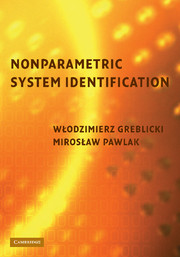Book contents
- Frontmatter
- Contents
- Dedication
- Preface
- 1 Introduction
- 2 Discrete-time Hammerstein systems
- 3 Kernel algorithms
- 4 Semirecursive kernel algorithms
- 5 Recursive kernel algorithms
- 6 Orthogonal series algorithms
- 7 Algorithms with ordered observations
- 8 Continuous-time Hammerstein systems
- 9 Discrete-time Wiener systems
- 10 Kernel and orthogonal series algorithms
- 11 Continuous-time Wiener system
- 12 Other block-oriented nonlinear systems
- 13 Multivariate nonlinear block-oriented systems
- 14 Semiparametric identification
- A Convolution and kernel functions
- B Orthogonal functions
- C Probability and statistics
- References
- Index
14 - Semiparametric identification
Published online by Cambridge University Press: 06 November 2009
- Frontmatter
- Contents
- Dedication
- Preface
- 1 Introduction
- 2 Discrete-time Hammerstein systems
- 3 Kernel algorithms
- 4 Semirecursive kernel algorithms
- 5 Recursive kernel algorithms
- 6 Orthogonal series algorithms
- 7 Algorithms with ordered observations
- 8 Continuous-time Hammerstein systems
- 9 Discrete-time Wiener systems
- 10 Kernel and orthogonal series algorithms
- 11 Continuous-time Wiener system
- 12 Other block-oriented nonlinear systems
- 13 Multivariate nonlinear block-oriented systems
- 14 Semiparametric identification
- A Convolution and kernel functions
- B Orthogonal functions
- C Probability and statistics
- References
- Index
Summary
In this chapter, we discuss the problem of identification of a class of semiparametric block-oriented systems. This class of block-oriented systems can be restricted to a parameterization that includes a finite-dimensional parameter and nonlinear characteristics that run through a nonparametric class of mostly univariate functions. The parametric part of a semiparametric model defines characteristics of linear dynamical subsystems and low-dimensional projections of multivariate nonlinearities. The nonparametric part of the model comprises all static nonlinearities defined by functions of a single variable. A general methodology for identifying semiparametric block-oriented systems is developed. This includes a semiparametric version of least squares and a direct method using the concept of the average derivative of a regression function. These general approaches are applied in cases of semiparametric versions of Wiener, Hammerstein, and parallel systems. Section 14.2 gives examples of semiparametric block-oriented systems. This includes the multivariate version of Hammerstein and Wiener systems. In Section 14.3, we give a general approach to semiparametric inference. Section 14.4 is devoted to an important case study concerning the semiparametric Wiener system. Sections 14.5 and 14.6 provide similar considerations for semiparametric Hammerstein and parallel systems. In Section 14.7, we derive direct estimation methods for semiparametric nonlinear systems.
Introduction
In all of the preceding chapters, we have examined various fully nonparametric block-oriented systems.
- Type
- Chapter
- Information
- Nonparametric System Identification , pp. 250 - 318Publisher: Cambridge University PressPrint publication year: 2008

